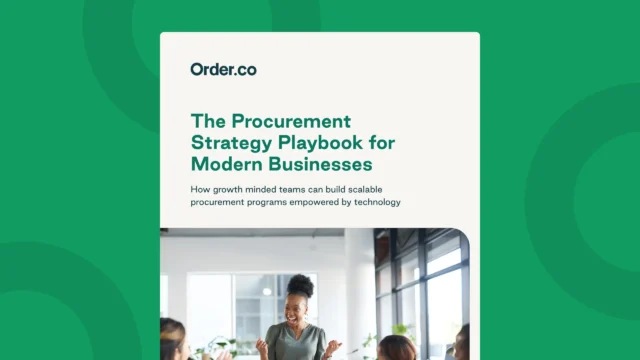How a Procurement Plan Template Simplifies the Buying Process

How a Procurement Plan Template Simplifies the Buying Process
Whether it’s a personal or corporate purchase, spending money without a plan is asking for trouble. For companies, that trouble might be budget overruns, maverick spending, risky purchases with third-party vendors, or even procurement fraud.
Fortunately, it’s easy to create a safe, repeatable procurement plan that holds every purchase to a high standard.
This step-by-step guide details how nailing the key elements of a procurement plan template helps you get from business case to order fulfillment and how technology can make the process even better.
Download the free guide: The Procurement Strategy Playbook for Modern Businesses
What is a procurement plan template?
A procurement plan template is a document that helps buyers or stakeholders outline a purchase. It guides decisions about what you need, who you'll buy from, how you'll carry out the purchase, and the costs involved. Having this blueprint for procurement and purchasing makes it easier to select the right supplies at the best price, achieve consistency, reduce errors, and build stronger supplier relationships.
Why should you use a procurement plan template?
Using a procurement plan template simplifies the vendor selection and transaction process. It standardizes the way your team evaluates suppliers, compares options, and completes new purchases. A repeatable process speeds up procurement and aids risk management, helping you realize more savings and complete deals with fewer issues.
Must-have elements in a procurement plan template
Building a procurement plan template is a structured way to simplify the procurement process and achieve cost efficiencies.
At a minimum, your template should outline:
- Purpose: Describe the business need and the procurement method for the purchase.
- Assumptions: Highlight any factors you believe might be true for planning (like price or delivery speed). Keep in mind that these may change as you evaluate the purchase and potential suppliers.
- Scope management: Define procurement limits, documenting aspects like how the goods will be used and whether they are for a specific project, location, department, or operational need.
- Resources: Detail the people, tools, and materials needed to evaluate and complete the procurement, such as stakeholders, reviewers, and required equipment or software.
- Implementation plan: Describe the step-by-step process for carrying out the procurement plan.
- Project schedule and milestones: Set deadlines and milestones to be sure you hit your selection and project completion targets.
Step-by-step approach to building a procurement plan
1. Define the plan objectives and scope
Get clear on your procurement goals before you start looking at numbers or picking out vendors. Without this context, it’s hard to know what success looks like or what challenges you may encounter.
- What need does this purchase address? The answer might be different for indirect spend procurement than for project-based purchases.
- How will this procurement help the project (or company) succeed? Also, consider if other resources (including those currently in-house) could serve the same purpose.
- Are there any quantifiable targets to hit? Consider operational goals, such as cost savings or efficiency improvements, that the project team should consider.
2. Name your project stakeholders
For many purchases, especially indirect spend projects like supply procurement, your purchasing and accounting teams will work together to process intakes, purchase orders, and payments. For larger procurement projects, you'll need project champions to manage the process and move the project forward.
Consider which stakeholders will help the procurement project get from planning to execution:
- Project managers who will oversee the project time frame, deliverables, stakeholders, and project objectives.
- End users and department leaders who will directly use the product or service. Their input can help define requirements and determine the project's success.
- The procurement team, which will perform contract negotiations, source suppliers, and manage the procurement process.
- The accounting and finance teams who will approve budgets, perform cost analysis, and handle payment processing.
- IT and security teams who will check technology purchases for compatibility, security, and support.
- Legal team members who will review contracts and agreements to protect your company's interests and ensure compliance with regulations.
- Senior management or executive team members who will approve major expenditures and strategic decisions.
- Suppliers who will provide the desired goods or services. Their engagement and management are critical to project success.
3. Outline your purchase requirements
A procurement plan helps you accomplish business goals while staying within policy and budget. Your current purchasing parameters are a great starting point for planning. Consider any guidelines or procurement strategy goals you’ll need to meet for purchase approval, such as:
- Rules about who can lead or approve a procurement project
- Approval process guidelines for different departments, like IT or legal
- Sustainability goals at the supplier or the product level
- In-contract vendors or negotiated pricing to consider during selection
- Industry or regulatory requirements for the products in question
Reviewing these prerequisites saves time and avoids headaches by ensuring your chosen supplier meets all selection criteria before you get to the negotiating table.
4. Set the project timeline
Document the deadlines for purchase, from initial engagement with suppliers to final delivery date and sign-off, including milestones to keep progress on track:
- Needs assessment
- RFP development
- Vendor selection
- Contract execution
- Delivery requirements
- Post-close tracking
Be sure to build in flexibility for delays and disruptions. Even when selection goes smoothly, McKinsey points out that finding a single supplier usually takes 3 months. Due to current trade restrictions and supply chain issues, the delivery timeline may be longer, even if you've purchased similar items before.
5. Finalize the project budget
As part of the plan, estimate the total cost of the purchase. This could come from your research insights during the needs assessment, data from your previous purchases, or industry benchmarks for similar products. Also consider the total value of the purchase, including aspects of the deal like tariffs, logistics, and financing fees. Showing cost and value makes it easier to get sign-off.
A template prevents you from leaving out important details that can slow down the review process and helps you organize everything necessary for a speedy approval.
Common best practices for successful procurement planning
Use these best practices to bring together the best data and measurement approach for your procurement plan. While centralizing data and establishing strong KPIs require an upfront time investment, it sets you up for a faster planning process in future deals.
Get a clear picture of your data
Data is the driving force of your project procurement management process. But to be useful, it needs to live in a single location. Creating total data visibility helps you analyze past purchases, contextualize current market trends, and choose the best suppliers.
The most common places to find procurement data include:
- Past purchase orders
- Procurement management systems or Excel spreadsheets
- Finance and procurement documentation
- Enterprise resource planning (ERP) systems
- Corporate card statements
- Expense reports
- Past benchmarking projects
- Supplier performance evaluations
- Negotiated contracts
You'll understand your current spending better once you have everything in one place. Benchmark data and supplier evaluation criteria can help you see how your contracts and vendor performance change over time. From there, you can build more accurate budgets and stronger business cases for purchases.
Choose the right metrics to track
Tracking procurement KPIs is the best way to measure success and make corrections. The key is choosing metrics that closely align with your stated goals.
Consider the following as you set up your KPI framework:
- Don’t rely too heavily on a single metric. Even if your goal is to cut costs or boost efficiency, you’ll need a balanced view of performance to know if your planning is working as intended.
- Be strategic about selection. Build a dashboard around 5–10 high-value performance metrics to track.
- Use a procurement KPI template to keep track of the metrics you want to measure.
Use a shortlist of potential suppliers
Create a shortlist of at least three suppliers for your project procurement. These should all meet your preliminary decision criteria, so you can focus on variables like pricing, delivery speed, and capacity.
Use your project goals to review and select the best vendor. This could involve a simple price comparison or an RFP process with a highest-and-best bid approach.
For more complex deals, consider using a weighted decision matrix or supplier evaluation process to get an objective view of your options. Be sure to look at any previous deals with potential suppliers for insights on past performance.
Is technology necessary for an effective procurement plan?
Managing procurement without a platform gets more difficult as you go. It leads to data silos and more errors. It can also bog down negotiations, increase risk, and create cash leaks.
Using a procurement platform like Order.co to plan purchases gives you several advantages over manual methods:
- Increased visibility across transactions
- Fewer manual tasks that slow down departments
- Reduced errors and procurement risks
- Better decision-making from a data-informed process
- Shorter procurement cycles with fewer delays
- Improved cash savings and working capital efficiencies
- Easier scaling as your procurement volume grows
While some companies get by with manual procurement planning, automation greatly enhances the procurement process.
Driving value with your procurement plan
A solid procurement plan is key to maintaining efficiency and security throughout the buying process. Order.co creates real-time visibility into every purchase, automates the repetitive parts of the process, and gives you access to thousands of vendors to meet your project needs and procurement policy standards.
With Order.co, you get access to the right mix of features and reporting to make your whole procurement process better:
- Customizable spend management controls by role, department, location, and budget
- Dynamic workflows to speed procurement and planning
- AI-powered strategic sourcing to find the best pricing across your vendor network
- Vendor management tools so you can track and manage every order
- AP automation to make invoice management, payments, and reconciliation easier
- Spend analysis tools for greater visibility and smarter decision-making
Take your procurement plan template further with modern procurement software that gives you full spend control and long-term savings. Schedule a demo of Order.co today.
Get started
Schedule a demo to see how Order.co can simplify buying for your business.
"*" indicates required fields



